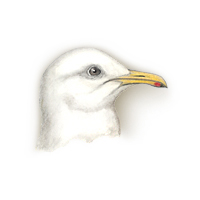 |
California Gull
Supersp #15 Larus californicus |
|
|
STANFORD LOCATIONS: Generally an uncommon visitor to campus from fall through spring. Usually seen foraging on playfields or at the Oval, where it may be locally common at times (especially when feeding on earthworms after rains). Also forages and bathes at Lagunita. |
 |
Location |
Type |
Mating System |
Parental Care |
2ndary Diet |
Strategy |
|
|
|
|
I: 25 (23-27) DAYS SEMIPRECOCIAL |
|
|
|
|
(1-5) MONOG |
MF |
VERTS |
| BREEDING: | Isles, open sand or gravel with scattered grass, or along lake and pond shores. 1 brood. |
| DISPLAYS: | Very similar to other members of superspecies #15. (See Herring Gull.) |
| NEST: | Of sticks, dried weeds, rubbish, feathers. |
| EGGS: | Brown/olive/gray/ olive-buff, marked with dark brown/gray. 2.7" (68 mm). |
| DIET: | Also worms, mice, other birds and their eggs, garbage; in winter, takes crabs and fish but mostly scavenges (esp fish). |
| CONSERVATION: | Winters s to n w Mexico. |
| NOTES: | Colonial, nests occ clustered within 2'-3' of each other. Inland breeder. This is the bird that saved Mormons from great plague of grasshoppers in 1848, and inspired seagull monument in Salt Lake City. More time spent preening and sleeping and less in defense than denser-nesting but similar Ring-billed Gulls. Feeding rate, nest attendance, reproductive success, central nesting position, all increase with age. Clutches of >3 result from abnormal female-female pairs, with no male involved. Usu do not breed until fourth year when adult plumage is attained. |
| ESSAYS: | Hybridization; Gull Development; Parent-Chick Recognition; Gulls Are Attracted to Their Predators; Coloniality; Superspecies. |
| REFERENCES: | Conover, 1984; Pugekse, 1983; Winkler, 1985. |
| Help | Abbreviations | Species-Alphabetical | Species-Taxonomic | Essays-Alphabetical | |
| Except for Stanford Locations, the material in this species treatment is taken, with permission, from The Birder's Handbook (Paul Ehrlich, David Dobkin, & Darryl Wheye, Simon & Schuster, NY. 1988). | |||||